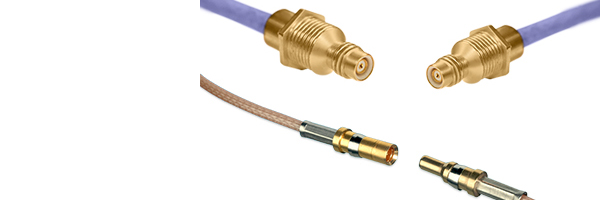Our complete line of RF coaxial and triaxial connectors and contacts include standard formats: MIL-DTL-38999, ARINC 404 and ARINC 600. RF micro connectors include high frequency coax, MDCX and MDHC.
Triax interconnect products include concentric twinax / triax connectors, contacts and cable assemblies. The triax connector line features our ultraminiature NDL-Q/NDL-T series offered in both threaded and quick disconnect versions.
Features:
- Compact size
- Superior RF high frequency electrical performance
- Rugged mechanical performance
- Float mount design ensuring high performance and low VSWR
- Size 5, 8, 9 and 12 contacts for various cable types and PC tail configurations
- Magnetic permeability preventing image distortion
Background
RF (Radio Frequency) connectors also known as coaxial connectors due to the connectors being design are to terminate to coaxial cable. Due to the frequency spectrum of RF it can be used to describe a range of frequencies. Other terms that are interchangeable with RF is microwave and depending on the cable being used a coax connector can be used over a frequency band of DC to 40 GHz.
A coaxial connector is used to terminate a cable to another connector that may be terminated to another cable or soldered directly into a pc board. Coaxial cable is used as a transmission line for radio frequency and digital signals, in applications such as connecting radio transmitters and receivers with their antennas, computer network connections, distributing cable television signals, military and commercial communications, surveillance, advance medical equipment, etc.
One advantage of coax over other types of transmission line is that in an ideal coaxial cable the electromagnetic field carrying the signal exists only in the space between the inner and outer conductors. This allows coaxial cable runs to be installed next to metal objects without the power losses that occur in other transmission lines, and provides protection of the signal from external electro magnetic interference (EMI).
Coaxial connector types are available for use in audio, video, digital, RF and microwave applications, each designed for a specific purpose and frequency. Generally, the smaller the connector, the higher the maximum operating frequency (cut-off). Much of the development of the smaller connectors that perform well into the high GHz and millimeter wave range originated in the development of test and measurement equipment including:
- Usually an RG or MIL-C-17 specification
- Standard copper conductors
- Mostly solid dielectrics (polyethylene, PTFE)
- Tin plated braided or served-wire shields
- Majority use plastic jackets
- Available from multiple manufacturers and distributors
VSWR (Voltage Standing Wave Ratio), is a measure of how efficiently radio-frequency power is transmitted from a power source, through a transmission line, into a load Insertion Loss: the loss of signal power resulting from the insertion of a device in a transmission line, expressed as decibels (dB).
A reflection coefficient describes the amplitude of a reflected wave relative to that of the incident wave. The reflection coefficient is closely related to the transmission coefficient.
Crosstalk (XT) is any phenomenon by which a signal transmitted on one circuit or channel of a transmission system creates an undesired effect in another circuit or channel. Crosstalk is usually caused by undesired capacitive, inductive, or conductive coupling from one circuit, part of a circuit, or channel, to another.
RF Leakage Cable signal leaks occur when the RF signals transmitted within a cable system are not properly contained within the cable plant. Cable signal leaks can be caused by loose connectors, damaged plant and cracked or unterminated cables.
Shielding Effectiveness: The reduction is field strength resulting from interposing a metallic barrier between a source and receptor of electromagnetic energy. In term of connector, contacts can be either the source or receptor of electromagnetic interferemce.
Dielectric constant: is the ratio of the permittivity of a substance to the permittivity of free space. It is an expression of the extent to which a material concentrates electric flux, and is the electrical equivalent of relative magnetic permeability.




